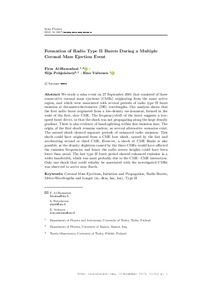Formation of Radio Type II Bursts During a Multiple Coronal Mass Ejection Event
Eino Valtonen; Firas Al-Hamadani; Silja Pohjolainen
https://urn.fi/URN:NBN:fi-fe2021042717989
Tiivistelmä
We study the solar event on 27 September 2001 that consisted of three
consecutive coronal mass ejections (CMEs) originating from the same
active region, which were associated with several periods of radio type
II burst emission at decameter-hectometer (DH) wavelengths. Our analysis
shows that the first radio burst originated from a low-density
environment, formed in the wake of the first, slow CME. The
frequency-drift of the burst suggests a low-speed burst driver, or that
the shock was not propagating along the large density gradient. There is
also evidence of band-splitting within this emission lane. The origin of
the first shock remains unclear, as several alternative scenarios exist.
The second shock showed separate periods of enhanced radio emission.
This shock could have originated from a CME bow shock, caused by the
fast and accelerating second or third CME. However, a shock at CME
flanks is also possible, as the density depletion caused by the three
CMEs would have affected the emission frequencies and hence the radio
source heights could have been lower than usual. The last type II burst
period showed enhanced emission in a wider bandwidth, which was most
probably due to the CME-CME interaction. Only one shock that could
reliably be associated with the investigated CMEs was observed to arrive
near Earth.
Kokoelmat
- Rinnakkaistallenteet [19207]
